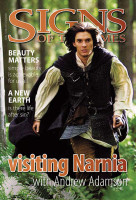For decades, C S Lewis's Chronicles of Narnia have been among the world's best-loved children's books. So whoever was going to be involved with adapting these stories in movie form was undertaking a difficult assignment.
In 2002, New Zealander Andrew Adamson was a surprise announcement to take the directing role for the first of these movies. Adamson had done visual effects work on a number of movies, including two Batman movies. He's also had significant success with the three Shrek movies. But moving from animation to a live-action adaptation of a children's classic seemed quite a stretch to some critics.
“In some ways, it's less different than you think,”
Adamson explained in a 2005 interview. “[But] the process is definitely different. In animation, you record the actor. Then you do the physical months later and the lighting months after that. In live action, you put everybody together in an environment. You get everything on camera. In animation, you have to think about everything. You have to think about blinks. You have to think about dust. You have to think about every drop of rain. In live action, you get that stuff for free.
“In the end, they kind of balance each other out. It's still storytime—it's still about human emotions. [The Lion, the Witch and the Wardrobe] used a lot of animation discipline.
They did have to take animated characters and give them human traits. So what I'd done in the past helped me to do this. At the same time, I was learning a lot from working with actors on location.”
And it seems the success of the first Narnia movie (2005) proved the critics wrong. Adamson co-wrote, co-produced and directed The Lion, The Witch and The Wardrobe and, most importantly, won over many of the long-time fans of the C S Lewis's stories, as well as introducing new audiences to the world of Narnia. The Lion, The Witch and The Wardrobe claimed a place in the top 30 box-office movies of all time.
“With The Lion, The Witch, and The Wardrobe, so many fans of the book already had high expectations,”
Adamson reflects. “And that's something you're very conscious of when making a film—it's hard. There's always an adaptation process. Things do change from book to screen, and you ask, ‘Did I make the right changes?' “The other thing I do is refer to my memory—I zero in on the things I remember from reading the book as a child. Those are the things it's important to be true to.”
the next chapter
Almost three years later, Narnia— and Adamson—return with Prince Caspian.
Shot in both New Zealand and central Europe, Adamson admits it is a darker story but explains that this is based on his commitment to be true to the book. “With the first film, I treated it as if I were telling the real story behind the story that C S Lewis wrote a children's book about,” he reflects. “He simplified it for children, but I was trying to find the real depth to it.”
But Adamson has also been mindful that the stories are first of all for children, which demands some restraint.
“I've shown bits of the film to kids of various ages because until you watch it with kids, you don't get a sense of what goes too far,” he says. “I've discovered there are definitely some things I need to pull back on a little bit. But what I generally find—and what I found on the last film, as well—is that children like to be scared as long as they feel secure.
“C S Lewis did it very well in the books, especially for younger children, because he would say something along the lines of ‘I can't tell you how bad this is because then your parents won't let you read the book.' So he sets up this thing in their imagination, then protects them, so that's what you try and do with the film—you don't keep them in this dark place for too long.”
This time, Adamson has faced the challenge of adapting a more complex story. “It's a challenge,” he says, “but sometimes the limitations you face actually create more interesting solutions.
And that's what I think makes this movie feel like a bigger movie, a more complex and interesting movie.”
NZ, PNG and beyond
Adamson was born in Auckland, New Zealand, in 1966. He remembers first encountering the stories of Narnia as an eight year old and admits the images he's recreated in the films are drawn from his first impressions of the stories.
From ages 11 to 18, Adamson lived in PNG, where his father worked at a university. Both of his parents were involved in church work. He says he still considers PNG as “kind of ...
home, because those years were so formative.”
“Living in New Guinea is an important part of my story in another way,”
Adamson told Christianity Today recently.
“When I tried to understand the Narnia stories from a kid's point of view, I realised the Pevensie kids were going through something I'd gone through. I went to this country when I was 11, and New Guinea has changed significantly since then. Basically, the place I grew up in doesn't exist anymore, so for me, there's a sense of loss.
“It's something we all go through in our passage from childhood to adulthood, when we realise we can't go back to the innocence of our childhood. We can't get back to the house being as big as we thought it was when we grew up.
And at some point, you have to say, ‘I accept that,' move on and become an adult. To me, that was the heart of this story [Prince Caspian] from Peter and Susan's point of view. And my own experience provided this sort of bittersweet, nostalgic framework for that.”
Adamson returned to New Zealand, planning to study architecture. But a car accident forced him to defer his studies for a year, in which time he toyed with computer animation, leading to employment in that direction.
About 16 years ago, he was recruited to work with computer graphics and effects in California, where he's been based since.
However, now married with two young children, and after an extremely busy past 10 years, Adamson is planning to step back a little. He has already signalled he will not be directing the next Narnia film and is in the process of moving his family back to New Zealand. “I haven't had a real break since the first Shrek, and I've been promising my wife I would have one since then,” he says. “So I think that if I want to keep my family, I'd better have one! On this film, I've been a lot stricter about my family time. With the first film, I had a much harder time balancing family time to work time. But on this film, I've several times said to myself, At the end of the day, it's just a movie, but my kids are my kids. The movie will get made but I'm not missing out on this thing with my kids.”
However, Adamson will continue as a producer and consultant on The Voyage of the Dawn Treader, the Narnia movie planned for release in 2010. He's also not ruling out the possibility of a greater involvement in further films.
“Assuming the audience wants it and the studio decides to make films of all the Narnia stories, if I were going to do another one, it'd probably be The Magician's Nephew,” he muses. “It's a prequel and it's about the creation of this amazing world and, because he wrote it after the others, C S Lewis was able to go back and tie up some of the various loopholes and paradoxes. It has a sense of completion to it and that would really appeal to me.”
faithful reading
Perhaps because C S Lewis and Narnia are admired by many Christian readers, Adamson has been reluctant to discuss his personal faith. “I've decided not to use these films as a platform or springboard for my own beliefs,”
he says. “I was very much expressing C S Lewis's story and allowing people to take from it whatever they took from the book.
“I think the ideas of good, evil, forgiveness and sacrifice are very present in the books, and I think that's what makes it so universally appealing. I think the idea of forgiveness is a human condition regardless of your belief or religion... .
“I didn't think a lot about the religious aspect of the film. I know people have interpreted the book in many different ways over the years. I read it when I was eight years old before I knew what the word ‘allegory' meant. I don't know if C S Lewis really intended it to be allegorical, but he definitely wrote from a place of his own belief.
And a lot of people get that from the book.”






